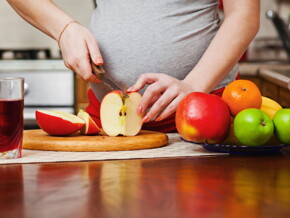
Eating for two doesn’t mean eating twice as much food, but it should mean making your food work twice as hard. Make every calorie count by choosing nutrient-dense foods, in other words get more bang for your calorie buck. By choosing a variety of food from all food groups, you can be assured of a well-balanced diet. But what if you have no appetite some days or occasionally feel nauseous? Remember, a quality diet over several days is what counts, not meal by meal.
What’s the right plan for me?
These food group guidelines, are an easy way to get started on a healthy pregnancy diet. Of course, your beginning weight, height, age, stage of pregnancy and the number of children you are carrying will determine how many calories and how much food you will need.
Typically a woman doesn't need extra calories during the first 3 months of pregnancy. But she will need about 300 extra calories during the second trimester and 450 extra calories during the third trimester.
Nutritional recommendations during pregnancy
| Fruits and/or vegetables | 5/day minimum |
During pregnancy, make sure that they are carefully washed to eliminate any soil traces, and avoid unpasteurised juices. |
| Breads, cereals, potatoes, rice and pasta | At each meal |
|
| Milk and dairy products | 3/day |
During pregnancy, only eat pasteurised dairy products. Cheese: melted or with the rind removed. |
| Meat, fish and eggs | 1-2/day |
During pregnancy:
|
| Fats and oils | Limit consumption |
|
| Sweets | Limit consumption |
|
| Drinks | Limit consumption |
During pregnancy and breastfeeding: No alcoholic drinks & no caffeinated beverages. |
| Salt | Limit consumption |
|
| Physical activities | At least 30 minutes’ walk everyday |
During pregnancy and breastfeeding, do not begin any new physical activity. |
SURPRISE!
Healthy fats, in moderation, are good for you. Choose unsaturated fats such as olive oil and nuts, seeds, avocado and salmon for their omega-3 fatty acids.
What is in your plate?
Here is a quick reference table which summarizes what these key nutrients do and in which foods to find them
| Nutrient | For | From |
|---|---|---|
| Protein | Important for growth and development | Meat, fish, eggs, cheese, beans |
| Carbohydrates | Supplies energy | Pasta, rice, bread, potatoes, vegetables, fruits |
| DHA (docosahexaenoic acid) | Important for brain and eye development | Fish, supplements |
| Probiotics | Gut immuty, allergy prevention | Probiotic product, such as probiotic yogurt, supplement |
| Vitamins | ||
|---|---|---|
| Folic acid | Prevents from neural tube defects | Dark green leafy vegetables, dried beans, nuts, wholemeal |
| Vitamin B1 (Thiamine) | Important for muscle function and growth | Meat, potatoes, wholemeal products |
| Vitamin B2 (Riboflavin) | Important for metabolism | Dairy products, meat, fish, eggs, wholemeal products |
| Vitamin B12 | Important for maturation of central nervous system | Fish, meat, poultry, dairy |
| Vitamin C | Important for immune system, collagen synthesis | Citrus fruit, peppers, tomatoes |
| Vitamin A | Important for growth and visual function | Carrots, spinach (as beta-carotene) |
| Vitamin D | Building bones | Fish, eggs yolks |
| Vitamin E | Muscles, antioxidant | Wheat germ oil, wholemeal products |
| Minerals & trace elements | ||
|---|---|---|
| Calcium | Important for bone and teeth formation | Milk, cheese, dairy products, broccoli |
| Magnesium | Regulates energy metabolism, nerve transmission, muscular contraction | Nuts, seed, wholemeal, vegetables |
| Iron | Important for increase in blood volume | Meat, spinach, lentils |
| Iodine | Growth metabolism | Fish, iodized salt |
| Selenium | Antioxidant | Meat, fish, egg, lentils, aspargus |
| Zinc | Growth, immune system | Meat, dairy products, fish |




























